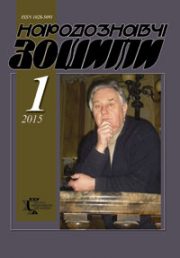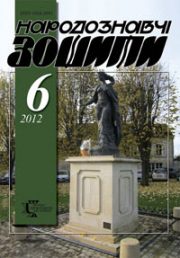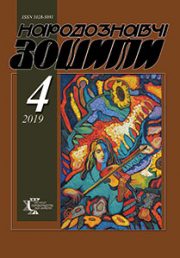The Ethnology Notebooks. 2018, 6 (144), 1430–1438
UDK: 391:746.1:677.017)024.1](477.83/.86)
DOI https://doi.org/10.15407/nz2018.06.1430
Received 21.11.2018
ORCID ID: https://orcid.org/0000-0002-1039-2920
Kutsyr Tetiana Vasylivna, Junior Researcher
at the Institute of Ethnology
of the National Academy of Sciences of Ukraine,
Folk Art Department,
15 Svobody Avenue, Lviv, 79000, Ukraine.
Contacts: Tel.: 0977522518; e-mail: sonechko_29@ukr.net
Abstract. The interest to Ukrainian folk costume has more increased in the last years. Numerous national and public events that took place during 2013—2018 showed a steady interest to this issue. Thus the study of little investigated or not enough illuminated issues of Ukrainian folk costume are actualized now. One of these remains Opillia folk costume and Opillia male folk costume in particular. The last one was characterized by simple, restrained composite solutions that can be adapted to modern dress. Therefore, the complex art analysis of Opillia male folk costume components, their constructive principles and combination into the complex variation has not only theoretical but also practical matters. In paper structural features and component’s variation of the Opillia male folk clothes of XIX — the first half of the XX centuries are described. Subject matter related to changing in cutting and tailoring during the definite period as well as main decoration features of base components. This ethnographic region clothes for different season and appointment (daily, festive) are analyzed, such as daily and festive shirts, different kind of outerwear (polotnianka, plakhta, sirak, opancha, kapota ets) as well as headwear and clothing accessories. The variety presented in the paper the male components of the folk costume demonstrated the organic unity of practical and decorative functions. Linen shirts and trousers were tailor made to suit requirements of comfort, but their material, proportions and clothing accessories helped to create a complete and perfect image. Outerwear of ХІХ century was perceived as festive and therefore was marked by a large cutting and decoration variation. Its bright polychrome decor with applique and embroidery as a compositional accent of the ensemble, indicated at the same time the place of come from of the owner.
Keywords: Opillia, male folk clothes, wear, component, cut, dйcor, ornamentation.
REFERENCES:
Andreeva, R.P. (1997). Entsiklopediya mody. Sankt-Peterburh: Litera [in Russian].
Art Department Fond of Lviv National Vasyl Stefanyk Library of Ukraine, f. J. Glogovsky. (1834). Glogovsky, J. In Wieњniaczk z Turynki, 11609.
Biletska, V. (1929). Ukrainski sorochky, yikh typy, evoliutsiia y ornamentatsiia. Materialy do etnolohii y antropolohii (Tom ХХІ—ХХІІ, part. 1) [in Ukrainian].
Chuhai, R.V. (1979). Narodne dekoratyvne mystetstvo Yavorivshchyny. Kyiv: Naukova dumka [in Ukrainian].
Hnatiuk, V. (1899). Kushnirstvo u Halychyni. Materialy do ukrainsko-ruskoi etnolohii (Tom I). Lviv: Drukarnia tov-va im. Shevchenka [in Ukrainian].
Hryiuk, S., Picnicki, J. (1995). The Land They Left Behind: Canada’s Ukrainian in the Homeland. Toronto: Watson Dwyer.
Golovatskiy, Ya. (1877). O narodnoy odezhde i ubranstve rusinov, ili russkikh v Galichine i severo-vostochnoy Vengrii. St. Peterburg: Tipografіya V. Kirshbauma, v d. Minister. Fin., na Dvorts. Ploshch [in Russian].
Kliuba, Ya., Berehovskyi, O, Boiko, L., ets. (Ed.). (2010). Opillia: monohrafiia. Halych: Davnii Halych [in Ukrainian].
Kosmina, O. (2013). Tradytsiine vbrannia ukraintsiv (T. I). Lisostep-step. Kyiv: Baltiia-druk [in Ukrainian].
Kulchytska, O. (2018). Narodnyi odiah zakhidnykh oblastei Ukrainy (zi zbirky Natsionalnoho muzeiu u Lvovi imeni Adreia Sheptytskoho). Albom-kataloh. In L. Kost’, N. Lenko (Ed.). Lviv: Apriori [in Ukrainian].
Kutsyr, T.V. (2014). Opillia Folk Costume Field Research Diary In Archive of the IN NANU (Archive of the Institute of Ethnology of the National Academy of Sciences of Ukraine). F. 1. Op. 2. Od. save 756. Arc. 1—41 [in Ukrainian].
Mateiko, K. (1977). Ukrainskyi narodnyi odiah. Kyiv: Naukova dumka [in Ukrainian].
Mateiko, K. (1996). Ukrainskyi narodnyi odiah. Etnohrafichnyi slovnyk. Kyiv: Naukova dumka [in Ukrainian].
Nikolaieva, T. (2005). Ukrainskyi kostium. Nadiia na renesans. Kyiv: Dnipro [in Ukrainian].
Putiatycki, Stanislaw. Kamianka Strumelowa (1840—1850). In Archive of National Museum of Ethnography in Warsaw, PME. Arch.I.3044.
Rzhegorzh, F.R. (1896). Iz putevykh zapisok. Iz L’vova v Kolomyyu. Kievskaya starina (T. 52, kn. 1) [in Russian].
Stelmashchuk, H.H. (2013). Ukrainske narodne vbrannia. Lviv: Apriori [in Ukrainian].
Vovk, Khv. (1928). Studii z ukrainskoi etnohrafii ta antropolohii. Praha: Ukrainskyi hromadskyi vydavnychyi fond [in Ukrainian].
Zawadzki, W. (1869). Obrazy Rusi Czerwonej. Poznan [in Poland].
Zubrytskyi, M. (1908). Verkhnia vovniana nosha ukrainsko-ruskoho naroda v Halychyni. Materialy do ukrainsko-ruskoi etnolohii (Tom X). Lviv: Drukarnia tov-va im. Shevchenka [in Ukrainian].







